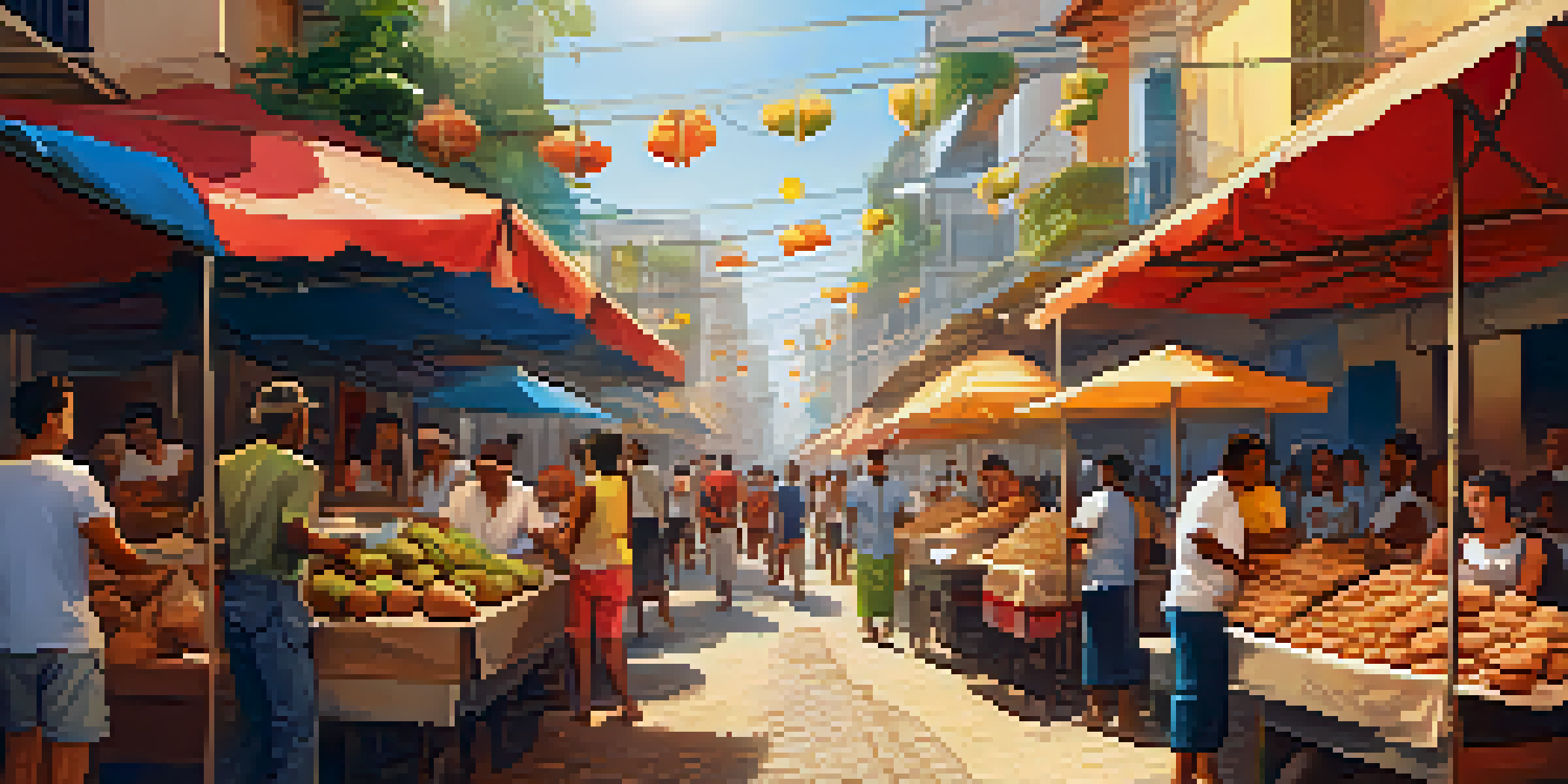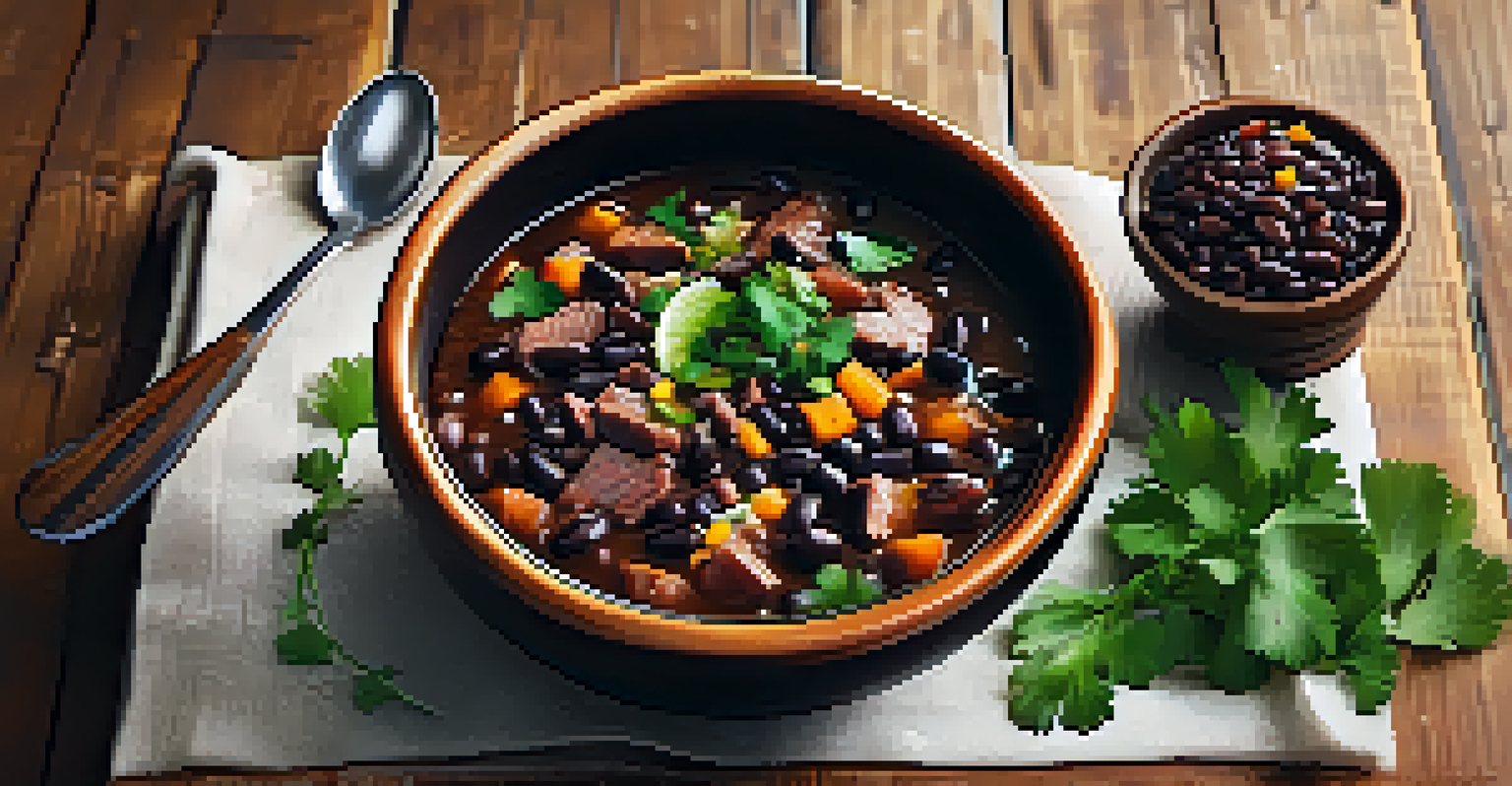Brazilian Cuisine: A Reflection of National Identity and Culture

The Melting Pot of Brazilian Cuisine
Brazilian cuisine is often described as a melting pot, reflecting the diverse cultural influences that shape the nation. From indigenous ingredients to Portuguese techniques, every dish tells a story of migration and adaptation. For instance, the use of cassava, a staple among the indigenous peoples, is now found in various forms across the country.
Food is our common ground, a universal experience.
The African influence is also significant, particularly in dishes like feijoada, a hearty black bean stew with pork. This dish originated from the African slaves who brought their culinary traditions to Brazil, showcasing resilience and creativity. Such examples underline how food is not just sustenance; it's a representation of history and identity.
As Brazil continues to evolve, so does its cuisine, incorporating elements from Asian and Middle Eastern cultures. This ongoing evolution emphasizes the dynamic nature of Brazilian identity, where each region boasts unique flavors and specialties, making the culinary landscape as varied as its people.
Regional Flavors and Their Significance
Brazil is vast, and its regions each contribute distinct flavors and dishes that reflect local resources and traditions. The Amazon region, for example, is known for its exotic fruits and fish, which are integral to its culinary identity. Dishes like tacacá, a soup made with tucupi and jambu, showcase the unique ingredients found in this rich ecosystem.

In contrast, the Northeast is famous for its use of spices and coconut, evident in dishes like acarajé, a deep-fried ball of black-eyed pea dough filled with shrimp. This region's cuisine is vibrant and bold, mirroring the culture's lively music and dance. The local ingredients and cooking methods tell stories of the land and its people.
Cultural Diversity in Brazilian Cuisine
Brazilian cuisine is a rich tapestry woven from indigenous, African, and immigrant influences, reflecting the country's diverse cultural identity.
Meanwhile, the Southern region offers a taste of European influence, particularly with its barbecue traditions. Churrasco, a Brazilian barbecue, is a communal experience that brings people together, emphasizing the importance of food in social interactions. These regional distinctions highlight how geography and culture intertwine in Brazilian cuisine.
Street Food: A Cultural Experience
Street food in Brazil is a vibrant aspect of its culinary culture, offering a taste of local life. Vendors serve up delicious treats like coxinha, a chicken-filled dough ball that’s crispy on the outside and soft inside. These snacks are not just food; they’re a glimpse into the daily lives of Brazilians, often enjoyed during festivals or casual outings.
Cooking is like love. It should be entered into with abandon or not at all.
Another popular street food is pastéis, which are deep-fried pastries filled with various ingredients such as cheese, meat, or vegetables. Found in bustling markets, these quick bites provide a convenient way to experience Brazilian flavors on the go. The lively atmosphere of street food stalls reflects the community spirit that characterizes Brazilian culture.
Moreover, street food fosters a sense of connection among people. Sharing a meal from a street vendor can lead to conversations and friendships, illustrating how food brings communities together. This aspect of Brazilian cuisine underscores the communal nature of eating, making it an essential part of cultural identity.
Celebrations and Culinary Traditions
Food plays a central role in Brazilian celebrations, marking significant cultural events throughout the year. For instance, during Carnaval, samba dancers and revelers often enjoy traditional dishes such as feijoada and moqueca, a fish stew that reflects the coastal flavors of Brazil. These meals are more than just food; they embody the spirit of festivity and unity.
Similarly, festive gatherings like the Festa Junina celebrate the harvest season with an array of traditional foods like pamonha and quentão. These dishes not only highlight regional specialties but also connect people to their agricultural roots. Each bite carries the essence of community and shared heritage.
Regional Flavors Shape Identity
Each Brazilian region offers unique dishes that highlight local ingredients and traditions, illustrating the connection between geography and culinary practices.
These culinary traditions serve as a reminder of Brazil's rich history and cultural diversity. Through food, Brazilians honor their ancestors and celebrate their unique identity, weaving a tapestry of flavors and stories that resonate with every generation.
Influence of Globalization on Brazilian Cuisine
Globalization has significantly impacted Brazilian cuisine, introducing new ingredients and cooking techniques from around the world. Sushi, for example, has become incredibly popular in Brazil, leading to the rise of sushi bars that blend Japanese flavors with local ingredients. This fusion highlights the country's openness to culinary experimentation.
Moreover, the influence of Italian cuisine is evident in the widespread love for pizza and pasta. In cities like São Paulo, you'll find pizzerias that serve unique Brazilian takes on classic Italian dishes, showcasing how cultural exchange enriches the culinary landscape. These adaptations reflect Brazil's dynamic nature as a culinary hub.
While globalization brings new flavors, it also raises questions about authenticity and tradition. Many chefs strive to balance modern influences with traditional recipes, ensuring that the essence of Brazilian cuisine remains intact. This ongoing dialogue between the old and the new is what keeps Brazilian cuisine vibrant and relevant.
Sustainable Practices in Brazilian Cooking
In recent years, there has been a growing emphasis on sustainable practices within Brazilian cuisine. Chefs and home cooks alike are increasingly aware of the environmental impact of their food choices. This shift is evident in the rise of farm-to-table restaurants that prioritize local, organic produce and sustainable seafood.
For instance, initiatives to reduce waste and promote seasonal ingredients have gained traction, allowing chefs to create dishes that celebrate the bounty of Brazilian agriculture. This not only supports local farmers but also enhances the flavor and quality of the food. Sustainability in cooking reflects a broader commitment to protecting the environment and fostering community.
Sustainability in Cooking
There is a growing commitment to sustainable practices in Brazilian cuisine, focusing on local produce and environmental stewardship.
Furthermore, traditional practices such as foraging for wild ingredients are being revived, connecting people to their natural surroundings. This approach not only enriches the culinary experience but also emphasizes the importance of biodiversity. Sustainable cooking in Brazil is more than a trend; it's a movement that honors the land and its resources.
The Future of Brazilian Cuisine
As we look to the future, Brazilian cuisine is poised for even greater evolution. Chefs are experimenting with new techniques and flavors, drawing inspiration from global culinary trends while staying rooted in tradition. This exciting fusion promises to keep Brazilian food fresh and innovative, appealing to both locals and international diners.
Moreover, the rise of social media has transformed how Brazilian cuisine is shared and celebrated. Platforms like Instagram allow chefs and food enthusiasts to showcase their creations, reaching a wider audience and sparking interest in traditional dishes. This digital age is creating a new generation of food lovers passionate about Brazil’s culinary heritage.

Ultimately, the future of Brazilian cuisine will continue to reflect the country's rich cultural tapestry. As new generations of chefs emerge, they will carry forward the legacy of their predecessors while adding their unique spin. This ongoing journey ensures that Brazilian cuisine remains vibrant, diverse, and deeply connected to the nation’s identity.